Many service and repair shops offer stock-replacement suspension components and provide basic alignment services. But there is more potential under the car than what is found in original equipment. It takes an enthusiast of at least moderate technical knowledge to appreciate the benefits of a well-tuned and matched system that minimizes body roll and optimizes weight transfer. When such a customer enters a shop looking for springs, dampers, bars and bushings—or even just a performance alignment for an existing handling package—he’ll expect to pay a fair price for top-quality parts and service. A shop that offers performance packages may also see customers who are looking for cosmetic changes only, wishing to lower a car to utilize a wheel and tire combination that better fills the wheel well. While those packages also promise good profit margins, the customer must be made aware that simple lowering doesn’t necessarily enhance performance.

“A good shop can prosper from adding performance suspension upgrades to its abilities,†said Edelbrock’s Arty Feles. “Many shops stay away from the installation of aftermarket performance upgrades because they have had bad experiences or problems with something not fitting properly. Shops can eliminate these types of problems by dealing with only products from reputable companies focused on design details, performance and high-quality workmanship. Look for complete, tested packages. Choose parts that are designed to work together. Do not attempt to piece together selections from various sources.â€
A complete system will include springs, struts, dampers and additional specialty parts that will allow proper installation and alignment. In most cases, a performance suspension system designed to improve handling will include lowering springs with a higher rate, meaning a stiffer spring.
“The stock shocks will not be able to properly dampen and control a spring that is stiffer than stock,†said Chuck Schwynoch, CEO of Maximum Motorsports Inc. “Keeping the stock shocks will cause the car to be under-damped. It will feel bouncy and disconnected from the road. Installing shocks that match the spring rates will improve both performance and ride quality. Knowledgeable vendors offer more complete packages to ensure that an emphasis on improving appearance does not sacrifice ride quality and handling. A shop just getting into selling performance parts should stick with a vendor that is an expert in the area and should consult directly with manufacturers of aftermarket parts. The shop should avoid trying to put together its own packages until it has gained a lot of experience in this area. The shop should be wary of customers who want to cut corners to save money. An example of this would be a customer who wants only lowering springs but does not want to purchase the matching struts and shocks. This sets the shop up for a comeback when the customer discovers that his car is under-damped, causing poor ride quality and poor handling.â€
The automakers design cars with economies of scale and middle-of-the-road performance in mind. A shop that wishes to attract performance enthusiasts must be able to offer products that will provide crisper handling and enhanced cornering capabilities.
“Service and repair shops may wish to limit aftermarket support to bolt-in products only,†advised Matt Jones, an engineer for Art Morrison Enterprises. “These types of products require little or no fabrication or welding, but they improve performance and aesthetics. They can range from items such as A-arm bushings to full suspension kits that replace almost every OEM component.â€
Lowering a vehicle through a shorter but stiffer spring also reduces the travel for absorbing a bump. Without progressive spring rates that increase when the wheel travels up or stiffer linear rates such as those found in motorsports applications, the suspension will bottom out more easily. Going too stiff will not only affect ride quality but, depending on the road conditions, available grip as well, according to Oliver Rathlein, director of sales and marketing for Eibach Springs Inc.
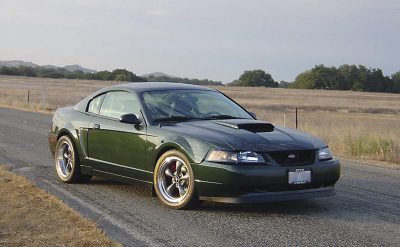
“The appearance customer is looking to get rid of the ugly fender gap without losing ride quality when going to plus-sized wheels and tires,†Rathlein said. “The smaller the sidewall, the more the fender gap is exaggerated. The performance customer is looking for a lower center of gravity, increased spring rates for reduced body roll when cornering and reduced squatting or nose-diving when accelerating or braking. With progressive spring rate designs, the initial rate is only slightly higher than stock, and the spring rate will increase, offering more performance as the suspension travels. I would recommend that shops use manufacturers that have TUV QS9000 and ISO 9001 quality approval, which allows them to be Tier 1 suppliers to any of the big automotive manufacturers. We make a lot of springs and sway bars for several OEs and private label for their performance divisions and select tuners.â€
It is also crucial that the shop determine what specific effect the customer is looking for. The suspension components used for street cruising will be different from those for canyon carving or track events such as autocross or drag racing, said John Hotchkis, president of Hotchkis Performance.
“A performance alignment for aggressive street driving has more negative camber and less toe-in than stock specs,†Hotchkis noted. “A car used for track-day events will have an even more aggressive alignment set-up. Repair shops should shy away from performance work if they are not equipped to tailor a vehicle to the owner’s needs. A certain amount of specialized work is required for each vehicle. Too low, and negative things happen to the suspension, including excessive camber, limited or no bump travel, driveline vibration, damage to shock absorbers, accelerated tire wear and vehicle instability. Properly designed suspension products can alleviate these problems. For example, camber plates and camber links can help restore and improve alignment specifications. A-arms can correct and improve camber curves and increase caster for more high-speed stability. Adjustable trailing arms and driveline shims or brackets can eliminate vibrations at a lower ride height.â€
For a suspension system to work properly, each component must be carefully matched to the others. For instance, higher-rated springs require more substantial shocks that may be adjustable and contain more fluid to control heat buildup during extreme conditions.
“Shock valving must complement spring rates,†explained Craig Morrison, marketing manager for Art Morrison Enterprises, “and spring rates must accommodate the vehicle’s characteristics, such as center of gravity, vehicle roll axis and desired ride stiffness.†Morrison reiterated that the goals for the vehicle, such as the desired cornering performance, must be matched with suspension hardware to maintain structural integrity yet minimize weight. “Anti-roll bars are often calculated after spring rates as a way to fine-tune body roll during cornering,†Morrison said. “Even small items such as anti-roll bar end links and A-arm bushing durometer can be used to fine-tune how a car handles at its limits.â€
Tailoring the handling to vehicle purpose entails understanding the geometry built into the vehicle at the factory and then adjusting the components to suit.
“You want to replace the OEM dampeners whenever you lower a vehicle because the increased rates will eventually wear out the stock dampeners over time anyway,†said Joey Berry, an inside sales consultant for Progress Technology. “Pick a spring that caters to the driving style and the road conditions. If you want more roll resistance without a sacrifice of ride height, anti-roll bars will do the trick. Keep alignment in mind when lowering a vehicle, because tires are another area with many choices. Price, road conditions and road noise all become factors in that decision.â€
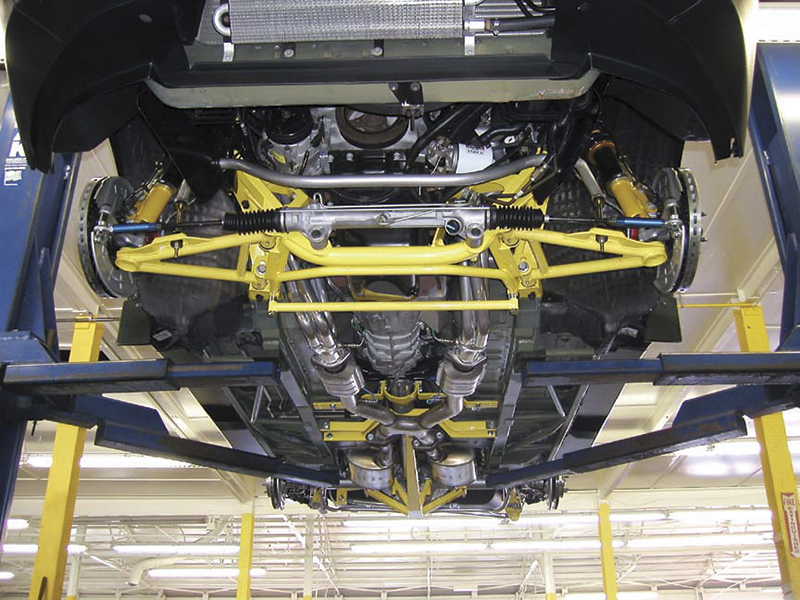

In fact, tires and wheels are usually the starting point in determining suspension changes. Sidewall size and stiffness as well as wheel size and weight may create chassis demands that limit other modifications.
“The wheel and tire package is often overlooked,†cautioned Bob Adams, business development manager for Steeda Autosports. “There has been a movement over the past several years to go to large-diameter wheels and reduce the size of the sidewall, but you have to have a satisfactory amount of deflection in the tire through a stiffer sidewall. Sometimes it’s better not to go with the absolute largest wheel you can buy. It makes more sense to go with a plus-one or a plus-two wheel and a performance tire that gives you aggressive sidewall construction. As you upsize the wheel, you’re increasing wheel weight, and that is unsprung weight.â€
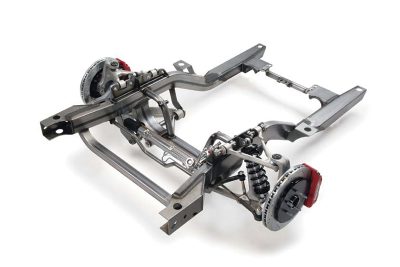
Unsprung weight consists of mass that is not supported by the vehicle’s springs, including the tires, wheels, brake rotors and spindles as well as live rear axles and some portion of the struts, shocks, springs and control arms. Sprung weight consists of the load that is suspended on the springs, which is the majority of the car.
“The lower the unsprung weight, the better the handling and the ride quality,†Schwynoch said. “Less unsprung weight allows the tire to more easily follow irregularities in the road surface because the struts and shocks have less weight to control. Keeping the tire in better contact with the road improves traction and cornering grip over rough surfaces. Reducing rotating weight by installing lighter tires and wheels will improve acceleration and braking because the engine has less mass to bring up to speed and the brakes have less work to do when stopping.â€
Because of their bulk and vehicle-specific nature, performance suspension products may be difficult to keep in continuous inventory along with stock-replacement parts.
“You could have a guy with a Camaro one day and a Mustang the next day, so it might be tough to stock exactly what will be needed for a specific car,†said Kevin Doyle, sales and marketing manager for Global West. “You probably want to keep inventory down so that you don’t have your money tied up, and you may not have the shelf space for a lot of parts. An installation shop is probably better off to order per job and then schedule a time for the customer to bring the car back for installation. A reliable warehouse distributor in the area might have everything in stock and be able to provide it all at once.â€
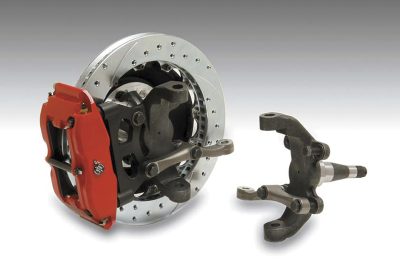
As with other types of performance products, marketing suspension modifications is a matter of reaching the niche enthusiasts who are looking for competent technicians and shops. Displaying at track days or offering contingency sponsorships at local autocross events as well as car shows will go a long way toward establishing credibility. Advertising in local publications that target enthusiasts is also beneficial, and most performance-suspension manufacturers offer literature and point-of-purchase materials to their dealers.
“You definitely need to get the message out to the enthusiasts,†Morrison advised, “so it’s best to go where they go. In addition, be sure that your company’s website is up to date, if you have one. It should include all of the information about what aftermarket parts you carry and, if possible, a few installation shots or ‘before and after’ pictures to help customers visualize what their own vehicles might look like. Lots of product information, catalogs and flyers are always helpful as well when customers are gathering information.â€
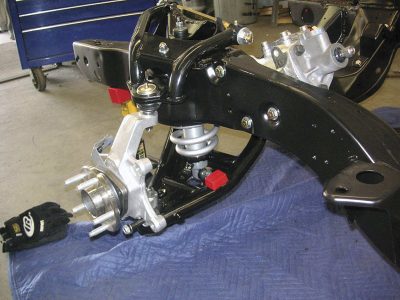
Marketing to the appearance customer may generate even more sales than seeking only those who want improved performance. Don’t alienate the more hardcore customers who are willing to sacrifice comfort for handling ability, but be honest about the pros and cons of different packages.
“The majority of customers want to improve the appearance of their cars,†said Schwynoch. “Their definition of improved appearance typically means a lowered stance and aftermarket wheels and tires. Most people will tolerate a slight degradation in ride quality, but they should be made aware that extreme changes would have a significant impact. The average consumer is more interested in appearance but would also appreciate an improvement in performance as long as the sacrifice in ride quality is not too great.â€
The automotive specialty-equipment industry is now selling parts to the tune of more than $35 billion per year. Personalizing a vehicle is no longer confined to a small group of enthusiasts. Now, even new-car dealers are using accessorization as a means to draw customers to the showroom, and performance modifications have become a significant source of profit for many shops. To learn more about the types of performance suspension products that may bring buyers to your business, seek advice and installation information from quality manufacturers. As Schwynoch put it, “They want to help you sell their products.â€

by Steve Campbell




0 Comments